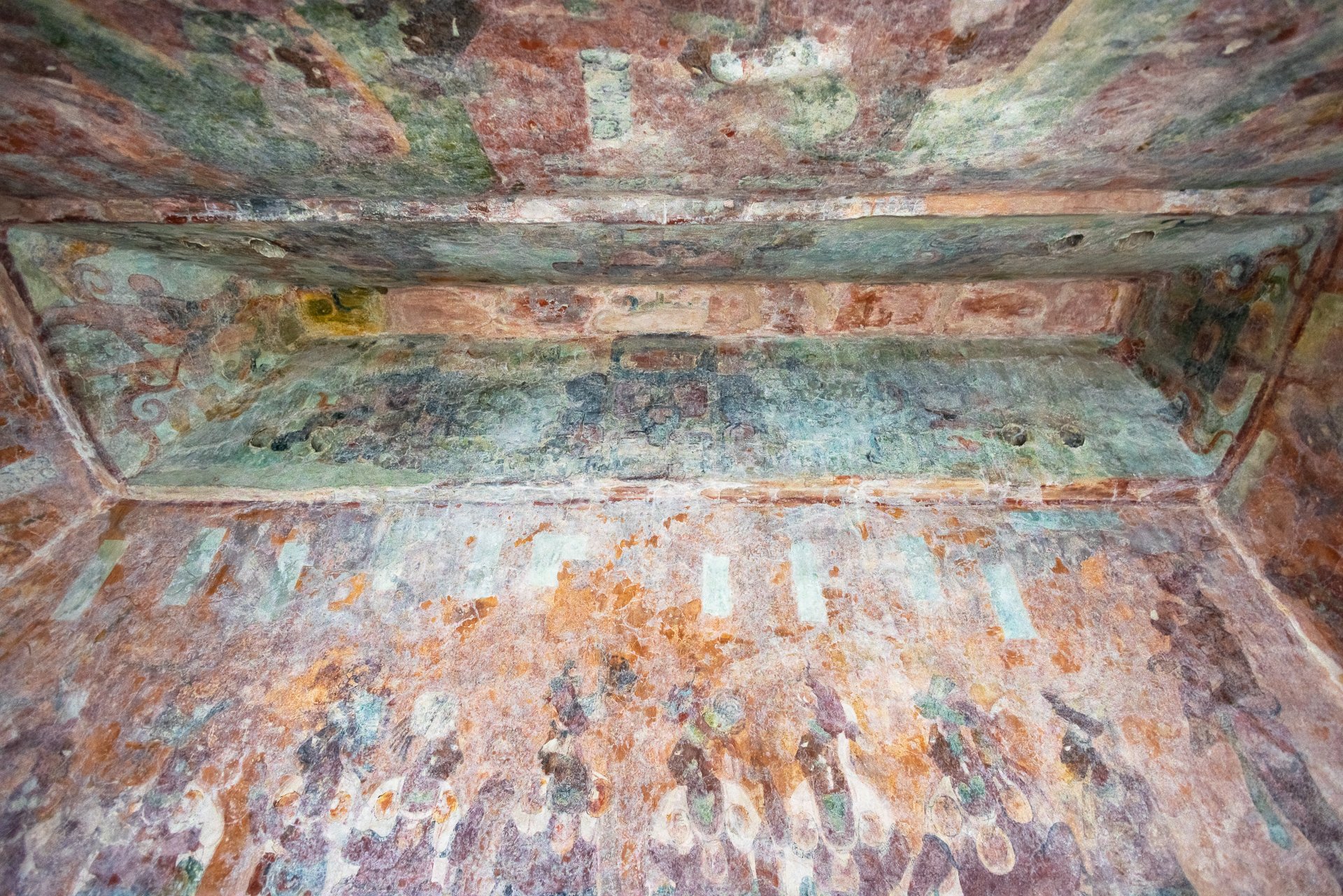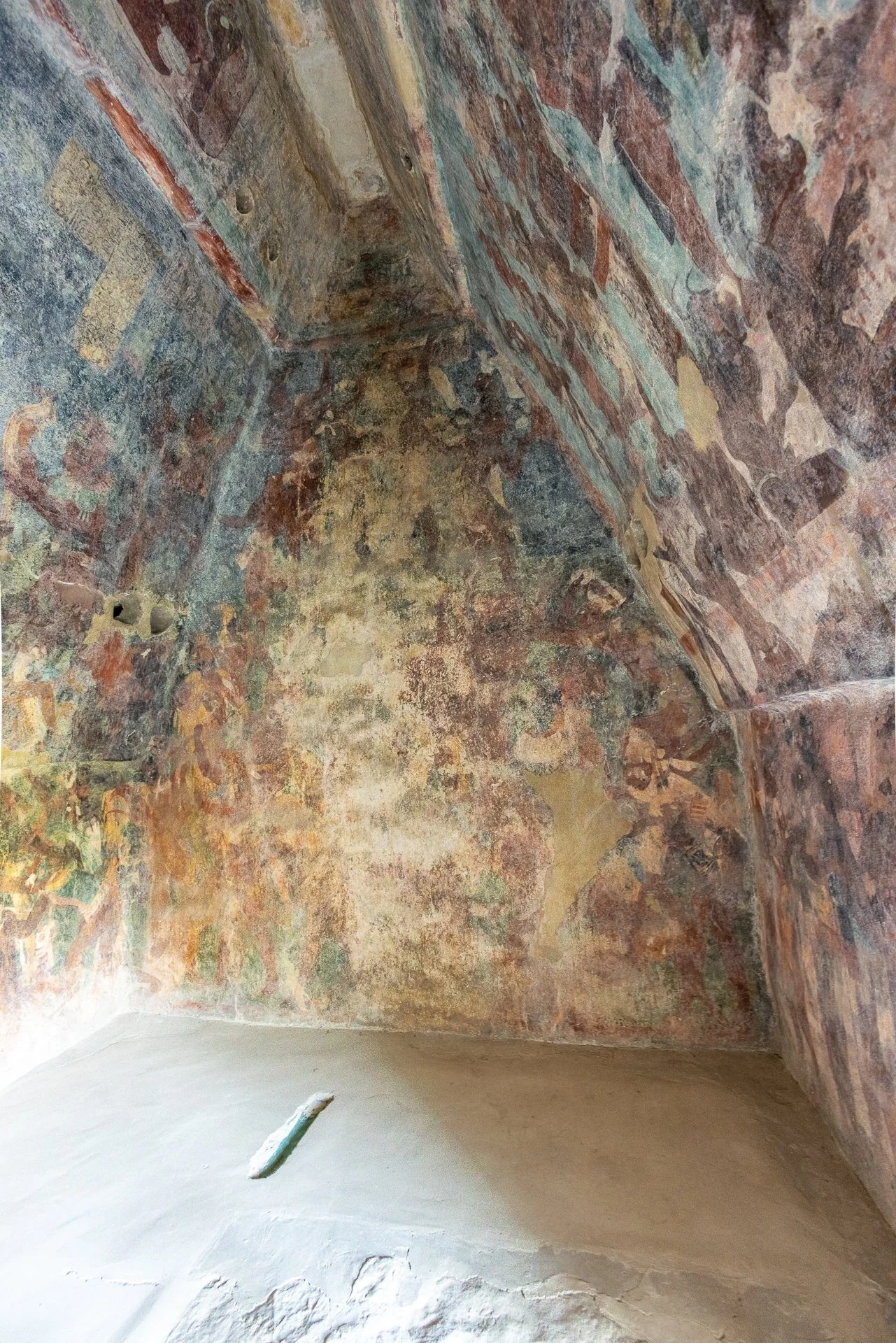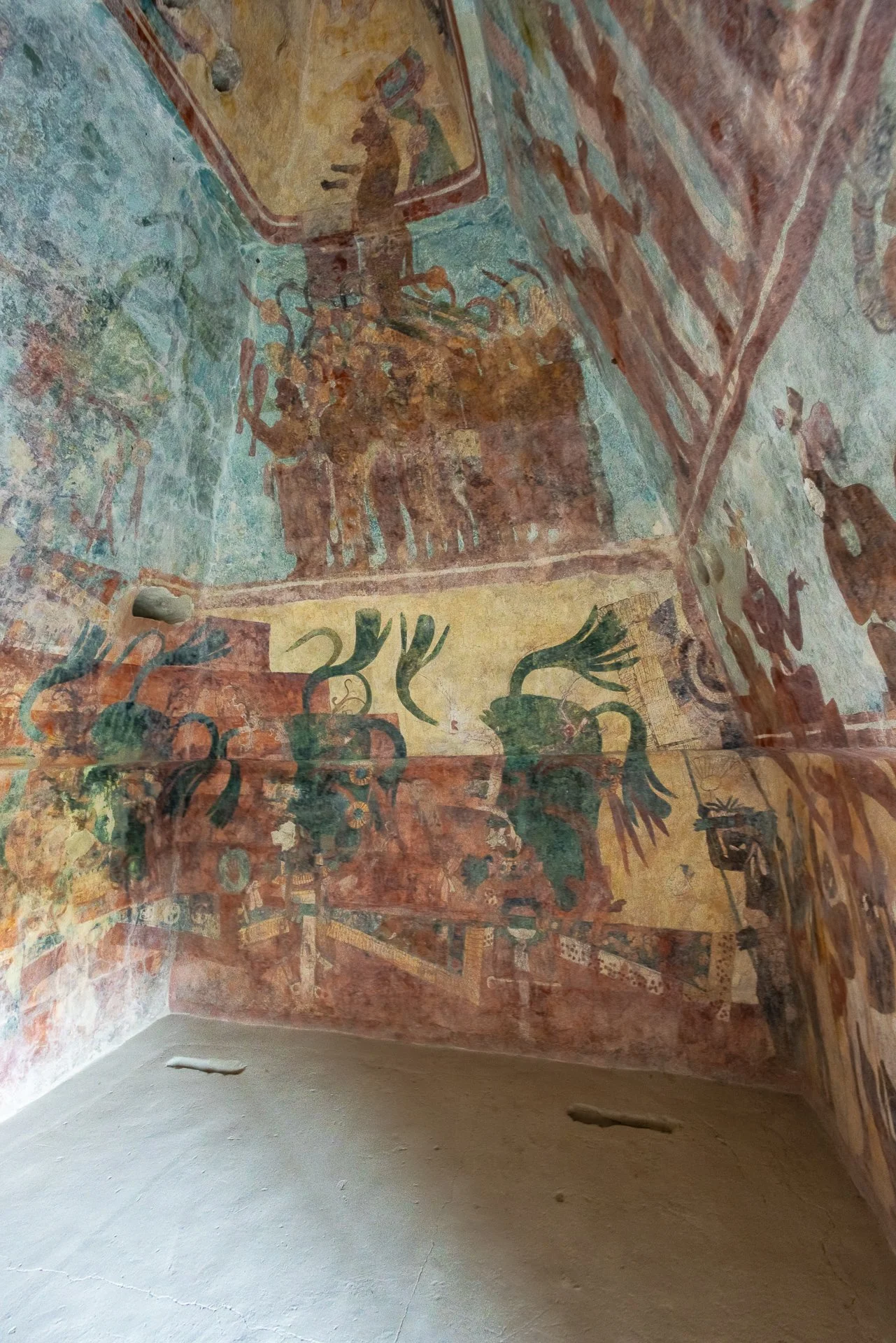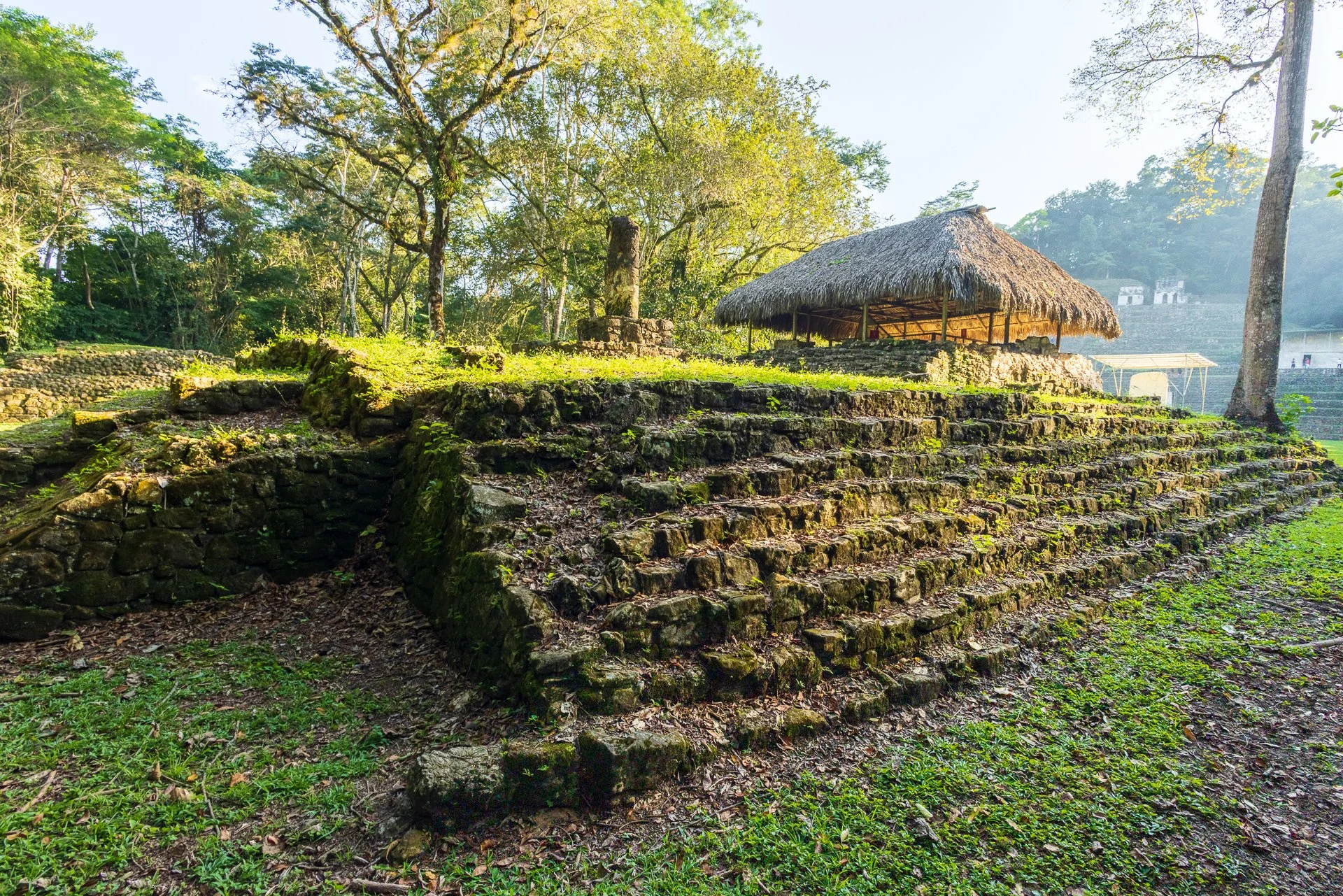Bonampak
Bonampak is an ancient Mayan archaeological site located in the state of Chiapas, Mexico. It is known for its well-preserved murals that depict the lives of the Mayan people and their rituals. The murals are considered one of the greatest achievements of Mayan art and offer valuable insights into Mayan culture and history. Currently photograhy and viewing in the alcoves is allowed, though you must wear a mask to reduce the moisture. Talks are ongoing to reduce or prevent viewings to preserve the paintings.
Sights & Culture
Grand Plaza
A vast open space that served as the social and economic hub of the ancient Maya city. This large rectangular plaza is surrounded by numerous structures that were once used for various purposes such as administrative, residential, and religious functions. The plaza is also home to several impressive and well-preserved stelae and altars that depict important historical events, gods, and rulers of the Maya civilization. The size and grandeur of the Grand Plaza, combined with the intricate artwork and architecture of the surrounding buildings, marks Bonampak as one of the most preserved sites.
Structure 1 - Temple of the Murals
One of the main attractions of Bonampak is the Temple of the Murals, which contains some of the most detailed and vibrant Maya murals in existence. The temple's walls are covered with scenes depicting battles, sacrifices, and other important events in the city's history.
Room 1
Room 1 of the Temple of the Murals at Bonampak is a spectacular sight to behold. This small rectangular room is entirely covered with beautifully-preserved frescoes that depict the pageantry and rituals of the ancient Maya civilization. The frescoes feature vivid and intricate details, including depictions of nobles, warriors, and priests engaged in activities such as dancing, playing musical instruments, and performing sacred ceremonies. The vibrant colours of the frescoes, combined with the detailed artwork and intricate symbolism, make Room 1 of the Temple of the Murals one of the most awe-inspiring examples of Maya art in existence.
The upper paintings show the presentation of Chan Muan's royal heir to an assembled court of fourteen Ahaus dressed in long white mantles. According to the date in the hieroglyphic text, this event took place on December 12, 790 A.D.
The lower paintings show musicians and dancers in a celebration honoring the new heir. This occurred on longcount date 9.18.1.2.0, or November 15, A.D. 791, a day when Venus rose as Evening Star. This date may have been chosen to assure that the young dynast would become a great warrior.
https://mayaruins.com/bonampak/bonampak_map.html#a1_355a
Room 2
Room 2 of the Temple of the Murals at Bonampak is another stunning example of Maya artistry and craftsmanship. This rectangular room is also entirely covered with frescoes, which showcase scenes from Maya mythology and cosmology. The frescoes in Room 2 are more complex and elaborate than those in Room 1, featuring detailed depictions of mythical creatures, deities, and celestial bodies. One of the most striking images is that of a Maya ruler sitting on a throne and surrounded by various attendants and dignitaries. The level of detail in the frescoes is simply breathtaking.
Robert Sharer writes: "Room 2 is filled with one of the true masterpieces of Maya art, a vivid and dynamic battle scene that covers the walls and vaults of all but the north side of the room.
The confusion and horror of hand-to-hand combat is brilliantly depicted, although the scene has suffered damage that obscures many of the details. Spears are thrust and thrown, one penetrates the forehead of a warrior, prisoners are pulled down by their hair, and pairs of victors combine to overwhelm single enemy warriors.
Robert Sharer, The Ancient Maya, p. 255
When the murals in Room 2 were discovered, they caused huge controversy among experts since the murals clearly depicted war, torture and bloody rituals at a time when it was believed the Maya were a peace loving people.
https://mayaruins.com/bonampak/bonampak_map.html#a1_321
Room 3
Room 3 of the Temple of the Murals at Bonampak is the smallest and most intimate of the three rooms, but still boasts an impressive collection of frescoes. This room is dedicated to the theme of warfare, featuring scenes of battle, conquest, and sacrifice. The frescoes depict warriors dressed in elaborate regalia, armed with weapons such as spears, shields, and clubs. The imagery is striking and dramatic, with warriors shown in the heat of battle, either attacking or defending themselves against their enemies. The attention to detail in the frescoes is incredible, with each figure carefully rendered and surrounded by a complex array of symbols and glyphs.
"The murals in Room 3 depict a final orgy of autosacrifice and captive dismemberment, all arrayed against a large pyramid that reaches around east, south, and west walls."
Mary Ellen Miller, Maya Art and Architecture, p. 176-77.
Maya aristocratic life seems to have been dedicated to living out predetermined cultural scripts which eventually became too expensive to maintain. Kathleen Berrin writes:
"The ideal script the lords and ladies wrote for their live increasingly may have been in disharmony with the world around them, and evidently the required price was too high."
Kathleen Berrin, Courtly Art of the Ancient Maya, p. 15
https://mayaruins.com/bonampak/bonampak_map.html#a1_321
Structure 15
Just to your left as you enter the Grand Plaza past the stalls, we watched a local girl disappear, diving headfirst over the walls into Structure 15. This structure itself was likely used for administrative or residential purposes, and it is one of the largest buildings at the site, measuring over 65 feet in length and 32 feet in height. The building features a large courtyard surrounded by multiple rooms and chambers, and it is decorated with intricate stucco reliefs that depict various scenes from Maya mythology and history.
Structure 16
This building is thought to have been used for residential or ceremonial purposes, and it features a single chamber with a raised platform at one end. The most striking feature of Structure 16 is its impressive stucco decoration, which covers the entire exterior of the building.
Structure 17
Structure 17 is an important building located in the central area of the Bonampak archaeological site. This structure is thought to have been a palace or administrative centre, and it features multiple chambers and rooms arranged around a central courtyard. Little is visible currently.
Stele 1
Stele 1 is a large stone monument located in the central plaza of the Bonampak archaeological site. This stele is one of the most important and impressive works of Maya art at the site, and it is believed to have been erected in the 8th century AD during the reign of the Bonampak ruler Chan Muwaan II. The stele features a carved relief on its front face that depicts Chan Muwaan II and his wife Lady Rabbit in richly detailed regalia, surrounded by courtiers and attendants. The relief is a remarkable example of Maya artistry, with each figure carefully rendered and adorned with intricate patterns and symbols. The hieroglyphic text on the stele provides important historical and genealogical information about Chan Muwaan II and his family, as well as details about their political and religious activities.
Stele 2
This stele is one of several erected at the site to commemorate important events or rulers in the history of Bonampak. Stele 2 features a carved relief on its front face that depicts a standing figure identified as the Bonampak ruler Yajaw Chan Muwaan II, who is shown wearing an elaborate headdress and holding a scepter. The relief is surrounded by a hieroglyphic text that provides important historical and genealogical information about Yajaw Chan Muwaan II and his family, as well as details about their political and religious activities.
Stele 3
This stele features a carved relief on its front face that depicts the Bonampak ruler Chan Muwaan III, who is shown standing atop a platform and wearing an elaborate headdress and ceremonial costume. The relief is surrounded by a hieroglyphic text that provides important historical and genealogical information about Chan Muwaan III and his family, as well as details about their political and religious activities.
Acropolis
The Acropolis at Bonampak is an ancient Maya archaeological site located in the Mexican state of Chiapas. The Acropolis is a complex of buildings located on a raised platform, which was the political and religious center of the city. The steps are narrow and some damaged so it can be a cautious challenge reaching the top, but it is worth the effort to see the ruins more closely and to see the view back over the site.
Shopping
Between where the van drops you off and the ruins themselves you run a gauntlet of stalls on both sides of the trails selling the usual selection of souveniers, snacks and drinks. The sellers are not aggressive and will leave you to pass. Perhaps the most important thing to note is they sell disposable masks which are required to view the murals, and if you’ve come all the way to Bonampak, you want to see the murals.
























